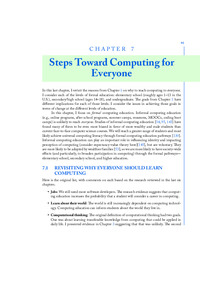Steps Toward Computing for Everyone |
 |
 Diese Seite wurde seit 1 Jahr inhaltlich nicht mehr aktualisiert.
Unter Umständen ist sie nicht mehr aktuell.
Diese Seite wurde seit 1 Jahr inhaltlich nicht mehr aktualisiert.
Unter Umständen ist sie nicht mehr aktuell.
 Zusammenfassungen
Zusammenfassungen
 In this last chapter, I revisit the reasons from Chapter 1 on why to teach computing to everyone. I consider each of the levels of formal education: elementary school (roughly ages 1–13 in the U.S.), secondary/high school (ages 14–18), and undergraduate. The goals from Chapter 1 have different implications for each of those levels. I consider the issues in achieving those goals in terms of change at the different levels of education.
In this last chapter, I revisit the reasons from Chapter 1 on why to teach computing to everyone. I consider each of the levels of formal education: elementary school (roughly ages 1–13 in the U.S.), secondary/high school (ages 14–18), and undergraduate. The goals from Chapter 1 have different implications for each of those levels. I consider the issues in achieving those goals in terms of change at the different levels of education.In this chapter, I focus on formal computing education. Informal computing education (e.g., online programs, after school programs, summer camps, museums, MOOCs, coding boot camps) is unlikely to reach everyone. Studies of informal computing education [34, 95, 143] have found many of them to be even more biased in favor of more wealthy and male students than current face-to-face computer science courses. We will reach a greater range of students and most likely achieve universal computing literacy through formal computing education pathways [130]. Informal computing education can play an important role in influencing identity and impacting perception of computing (consider expectancy-value theory here)[145], but are voluntary. ey are more likely to be adopted by wealthier families [53], so we are more likely to have society-wide effects (and particularly, to broaden participation in computing) through the formal pathways - elementary school, secondary school, and higher education.
 Dieses Kapitel erwähnt ...
Dieses Kapitel erwähnt ...
 Dieses Kapitel erwähnt vermutlich nicht ...
Dieses Kapitel erwähnt vermutlich nicht ... 
 Tagcloud
Tagcloud
 Volltext dieses Dokuments
Volltext dieses Dokuments
 Anderswo suchen
Anderswo suchen 
 Beat und dieses Kapitel
Beat und dieses Kapitel
Beat hat Dieses Kapitel während seiner Zeit am Institut für Medien und Schule (IMS) ins Biblionetz aufgenommen. Beat besitzt kein physisches, aber ein digitales Exemplar. (das er aber aus Urheberrechtsgründen nicht einfach weitergeben darf). Es gibt bisher nur wenige Objekte im Biblionetz, die dieses Werk zitieren.











 Computer
Computer Geometrie
Geometrie Kinder
Kinder Lernen
Lernen LOGO (Programmiersprache)
LOGO (Programmiersprache) micro:bit
micro:bit Primarschule (1-6) / Grundschule (1-4)
Primarschule (1-6) / Grundschule (1-4) Programmieren
Programmieren Schule
Schule Scratch
Scratch Sekundarstufe I
Sekundarstufe I Squeak
Squeak turtle graphics
turtle graphics , 453 kByte)
, 453 kByte)  Biblionetz-History
Biblionetz-History